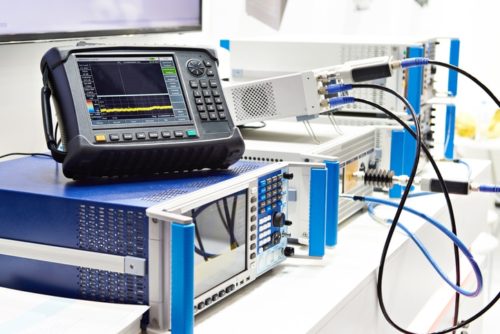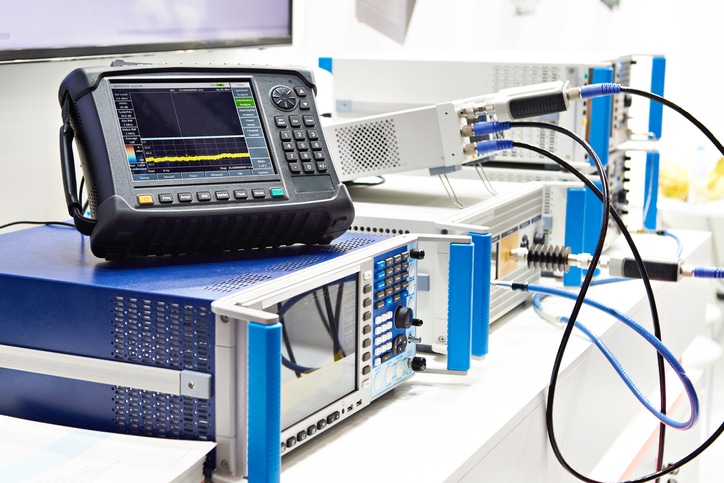
Test requirements for equipment designed for use on military platforms include a number of power quality standards. These standards evaluate the equipment’s ability to operate normally when subjected to disturbances characteristically found on their platform of intended use. They also place limits on the level of disturbance the equipment can contribute to the voltage distribution network.
Power distribution systems are subject to extreme variances and disturbances caused by devices that share the system. They can also have disturbances caused by variances in power generation devices such as generators and alternators. Inductive load dumps, spikes and surges, coupled interference, voltage fluctuations, and frequency variations can all cause significant disturbances in equipment’s normal operation that could lead to hazardous conditions or render the equipment inoperable. Because of this, military standards for evaluation of these phenomena can place stringent demands on Equipment Under Test (EUT).
MIL-STD-1275
MIL-STD-1275 “Characteristics of 28 Volt DC Power Input to Utilization Equipment in Military Vehicles” is a series of tests that simulate expected variances on vehicle power distribution systems. Test also evaluate variances emitted by the equipment under test to ensure that the equipment does not contribute excessive disturbances to supply voltage inputs. Test methods employed in this evaluation include:
- Operational Voltage Range – For this test the EUT is powered at 20 and 30 Volts DC for 30 minutes at each voltage.
- Voltage Ripple – The Voltage Ripple test is in fact a variance of MIL-STD-461 CS101. with the upper test frequency extended from 150 kHz to 250 kHz.
- Starting Operation including Initial Engagement Surges and Cranking Surges.
- Voltage Spikes both emitted and injected.
- Voltage Surges both emitted and injected.
- Reverse Polarity – For this test the EUT is powered at 33 Volts with reverse polarity for five minutes.
All of these tests can be challenging, but in particular the surge test can result in smoke emanating from power input circuitry, a disappointing end of a trip to the lab to be certain.
MIL-STD-704
MIL-STD-704 “Aircraft Electrical Power Characteristics” evaluates equipment for power distribution systems present on U.S. military aircraft platforms. Separate matrices of evaluation are performed based on the type of power input the equipment utilizes. Power types include:
- Single Phase, 400 Hz, 115 VAC
- Three Phase, 400 Hz, 115 VAC
- Single Phase, Variable Frequency, 115 VAC
- Three Phase, Variable Frequency, 115 VAC
- Single Phase, 60 Hz, 115 VAC
- 28 Volts VDC
For any of the above power types, as many as 18 various tests are to be conducted. These tests include Current Harmonic Measurements, Voltage and Frequency Modulations, Transients, Interrupts, Emergency Limits, and Phase Reversals.
Consideration for classes of equipment and their level of immunity are covered in this standard. For example, a coffee pot can be rendered momentarily inoperable but a flight navigational system cannot. In no case can equipment equipment under test suffer damage or cause an unsafe condition. As with MIL-STD-1275 limits are placed on disturbances the equipment contribute to the electric power system.
MIL-STD-1399-300
MIL-STD-1399-300 “Electric Power, Alternating Current” provides test methodologies for evaluating equipment for shipboard operation. As with any of the aforementioned standards, limits and specifications are mandatory.
This standard is broken up into two parts. Part one covers low supply voltages (115 or 440 VAC). Part two covers medium voltage supplies from 4,160 VAC to 13,800 VAC. Required testing includes variances in Voltage and Frequency, Voltage Spikes, Emergency Conditions, Grounding Tests, Equipment Profile Tests, Current Waveform Tests, Simulated Human Body Leakage Current, Equipment Insulation Tests, and Active Ground Tests.
Designing Equipment for Power Sources
Military power quality testing is a specific set of methodologies that examine equipment’s ability to operate when subjected to extreme characteristics of electric power to ensure compatibility in their intended environments. While being associated Electromagnetic Compatibility (EMC) and Electromagnetic Immunity (EMI) it presents specific challenges to equipment designers.
In many cases, specially designed power supplies can be utilized to provide protection from electrical supply disturbances and distortions. However, when equipment is designed to control large inductive loads, care must be taken early in design to ensure that the equipment does not itself cause power distribution issues.
CVG Strategy Test and Evaluation Experts
CVG Strategy offers a wide array of services to assist you with EMI/EMC and electrical product evaluation to keep your product development on schedule. We also can provide EZ-Test Plan Templates for MIL-STD-461, MIL-STD-1275, MIL-STD-704, and MIL-STD-1399-300.
CVG Strategy can also provide guidance for MIL STD environmental testing including performance of a Life Cycle Environmental Profile as required for MIL-STD-810. Our engineers can perform design analysis to identify potential design issues before testing. We can also assist in developing test programs for product verification and validation.



